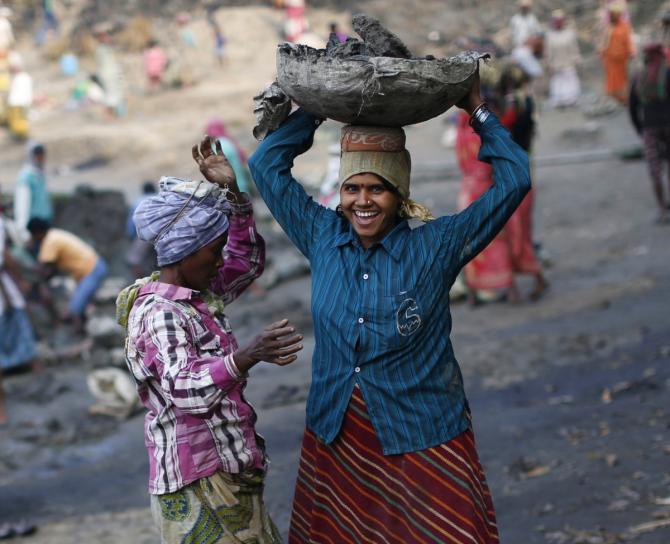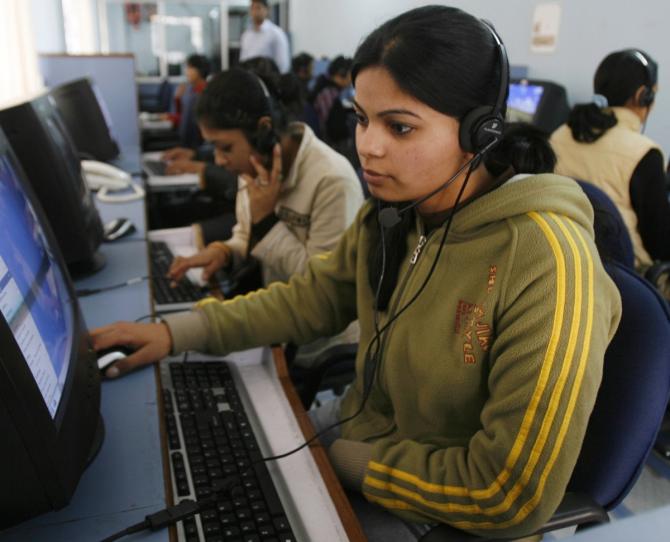'By November 2020, men recovered most of their lost jobs, but women were less fortunate: 49 per cent of the job losses by November were of women.'
'The recovery has benefited all, but it benefited women less than it did men,' notes Mahesh Vyas.

India's biggest challenge on the employment front is getting its women folk into the labour force.
While 67 per cent of all men of working age are employed, only 9 per cent of all women of working age are.
This gap between men and women in India's workforce is the potential labour available to deploy productively in economic activities.
Given that men continue to be considered as the principal earning member of a household, women are unlikely to accept poor quality jobs.
Household incomes have risen to a point where employment for women as a second earning member of a typical household is not as much of a necessity as it is a choice.
Such a choice will be exercised only if the job on offer is of good quality without punishing working conditions or prohibitive transaction costs.
But, good jobs are on the decline. Formal jobs that provide opportunities to build a career are not the ones that are growing.
Informal jobs -- now also with a fashionable component as gigs -- are more common. Contractual jobs are on the rise.
Large companies that provided good quality jobs have chosen to outsource jobs to contractors who engage labour on poorer terms than offered by the large firms to labour directly.

Women face a particularly hard time in these deteriorating labour market conditions.
Although the labour participation rate for women is very low, at less than 11 per cent compared to 71 per cent for men, they face a much higher unemployment rate of 17 per cent compared to 6 per cent for men.
The much fewer women who seek work find it much harder to find work compared to men. This is disconcerting as it suggests a bias against employing women.
Young women who make efforts to join the labour force first face these extremely adverse conditions of the labour markets.
Then, they soon face difficulties in managing responsibilities at home and of motherhood.
It is, therefore, not very surprising that economic shocks hit women's participation in the labour markets disproportionately.
Women accounted for 10.7 per cent of the workforce in 2019-20, but they suffered 13.9 per cent of the job losses in April 2020, the first month of the lockdown shock.
By November 2020, men recovered most of their lost jobs, but women were less fortunate: 49 per cent of the job losses by November were of women. The recovery has benefited all, but it benefited women less than it did men.
Data from CMIE's Consumer Pyramids Household Survey (CPHS) show two disturbing trends with respect to women's participation in the workforce in India.
First, urban women participate far less in the workforce than rural women.
In 2019-20, female labour participation rate (FLPR) among urban women was 9.7 per cent against 11.3 per cent among rural women.
Both participation rates are very low, but the lower rate among urban women runs against expectations.
This is because urban women are expected to be better educated and because urban India is expected to offer them better and more jobs than rural India.
The lockdown experience of urban women is particularly distressing in this respect.

In April 2020, the urban FLPR fell to 7.35 per cent, which was over 200 basis points lower than its average of 9.7 per cent in 2019-2020.
But, unlike many other indicators, the urban FLPR did not recover. On the contrary, it effectively continued to slide.
In October 2020, female labour participation in urban India dropped to 7.2 per cent -- the lowest since CMIE began measuring this indicator in 2016.
Data for November show that the fall in urban FLPR in October was not a mere outlier; it fell further to 6.9 per cent.
The second observation from the CPHS is about the impact of economic shocks on younger women who join the labour force.
The young women we talk about here are those in their early twenties. And, the data we use for this is Wave-wise. The CPHS is conducted over a four-month period and each such period is called a Wave.
In the Wave of January-April 2016, the female labour participation rate was 15.7 per cent. This rose to 16.4 per cent in the May-August 2016 Wave.
It then fell in each of the next three Waves to stabilise at around 11 per cent in response to the demonetisation shock. Then, it fell again in response to the lockdown shock in 2020 to close to 9 per cent.
The behaviour of young women is different. Their participation fell from 18 per cent before demonetisation to nearly 10 per cent in a year after demonetisation. They suffered a greater hit than the rest of the women.
A year after that in 2018, the labour participation of young women started rising again. It reached 14.3 per cent by the end of 2019. This was very promising. But, it was interrupted again by another economic shock -- the lockdown.
FLPR of young women plummeted to 8.7 per cent. Going by past experience, it would take a few years before this damage can be repaired. And in the meanwhile it is imperative that there are no more economic shocks.
Mahesh Vyas is MD and CEO, CMIE P Ltd
Feature Presentation: Rajesh Alva/Rediff.com












 © 2025
© 2025